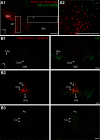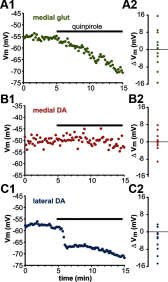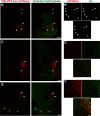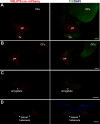Ventral tegmental area glutamate neurons: electrophysiological properties and projections
- PMID: 23100428
- PMCID: PMC3685320
- DOI: 10.1523/JNEUROSCI.3128-12.2012
Ventral tegmental area glutamate neurons: electrophysiological properties and projections
Abstract
The ventral tegmental area (VTA) has a central role in the neural processes that underlie motivation and behavioral reinforcement. Although thought to contain only dopamine and GABA neurons, the VTA also includes a recently discovered population of glutamate neurons identified through the expression of the vesicular glutamate transporter VGLUT2. A subset of VGLUT2(+) VTA neurons corelease dopamine with glutamate at terminals in the NAc, but others do not express dopaminergic markers and remain poorly characterized. Using transgenic mice that express fluorescent proteins in distinct cell populations, we now find that both dopamine and glutamate neurons in the medial VTA exhibit a smaller hyperpolarization-activated current (I(h)) than more lateral dopamine neurons and less consistent inhibition by dopamine D(2) receptor agonists. In addition, VGLUT2(+) VTA neurons project to the nucleus accumbens (NAc), lateral habenula, ventral pallidum (VP), and amygdala. Optical stimulation of VGLUT2(+) projections expressing channelrhodopsin-2 further reveals functional excitatory synapses in the VP as well as the NAc. Thus, glutamate neurons form a physiologically and anatomically distinct subpopulation of VTA projection neurons.
Figures






Similar articles
-
Functional Connectome Analysis of Dopamine Neuron Glutamatergic Connections in Forebrain Regions.J Neurosci. 2015 Dec 9;35(49):16259-71. doi: 10.1523/JNEUROSCI.1674-15.2015. J Neurosci. 2015. PMID: 26658874 Free PMC article.
-
Glutamatergic Ventral Pallidal Neurons Modulate Activity of the Habenula-Tegmental Circuitry and Constrain Reward Seeking.Biol Psychiatry. 2018 Jun 15;83(12):1012-1023. doi: 10.1016/j.biopsych.2018.01.003. Epub 2018 Jan 12. Biol Psychiatry. 2018. PMID: 29452828 Free PMC article.
-
Dopaminergic terminals in the nucleus accumbens but not the dorsal striatum corelease glutamate.J Neurosci. 2010 Jun 16;30(24):8229-33. doi: 10.1523/JNEUROSCI.1754-10.2010. J Neurosci. 2010. PMID: 20554874 Free PMC article.
-
Glutamate neurons within the midbrain dopamine regions.Neuroscience. 2014 Dec 12;282:60-8. doi: 10.1016/j.neuroscience.2014.05.032. Epub 2014 May 27. Neuroscience. 2014. PMID: 24875175 Free PMC article. Review.
-
Dopamine-glutamate neuron projections to the nucleus accumbens medial shell and behavioral switching.Neurochem Int. 2019 Oct;129:104482. doi: 10.1016/j.neuint.2019.104482. Epub 2019 Jun 3. Neurochem Int. 2019. PMID: 31170424 Free PMC article. Review.
Cited by
-
Whole-brain efferent and afferent connectivity of mouse ventral tegmental area melanocortin-3 receptor neurons.J Comp Neurol. 2021 Apr 15;529(6):1157-1183. doi: 10.1002/cne.25013. Epub 2020 Sep 10. J Comp Neurol. 2021. PMID: 32856297 Free PMC article.
-
Opioid modulation of ventral pallidal afferents to ventral tegmental area neurons.J Neurosci. 2013 Apr 10;33(15):6454-9. doi: 10.1523/JNEUROSCI.0178-13.2013. J Neurosci. 2013. PMID: 23575843 Free PMC article.
-
Molecular Regulation in Dopaminergic Neuron Development. Cues to Unveil Molecular Pathogenesis and Pharmacological Targets of Neurodegeneration.Int J Mol Sci. 2020 Jun 3;21(11):3995. doi: 10.3390/ijms21113995. Int J Mol Sci. 2020. PMID: 32503161 Free PMC article. Review.
-
Vesicular neurotransmitter transporters in Drosophila melanogaster.Biochim Biophys Acta Biomembr. 2020 Dec 1;1862(12):183308. doi: 10.1016/j.bbamem.2020.183308. Epub 2020 Apr 17. Biochim Biophys Acta Biomembr. 2020. PMID: 32305263 Free PMC article. Review.
-
Increased hippocampal excitability and impaired spatial memory function in mice lacking VGLUT2 selectively in neurons defined by tyrosine hydroxylase promoter activity.Brain Struct Funct. 2015 Jul;220(4):2171-90. doi: 10.1007/s00429-014-0778-9. Epub 2014 May 7. Brain Struct Funct. 2015. PMID: 24802380 Free PMC article.
References
-
- Bäckman CM, Malik N, Zhang Y, Shan L, Grinberg A, Hoffer BJ, Westphal H, Tomac AC. Characterization of a mouse strain expressing Cre recombinase from the 3′ untranslated region of the dopamine transporter locus. Genesis. 2006;44:383–390. - PubMed
-
- Borgius L, Restrepo CE, Leao RN, Saleh N, Kiehn O. A transgenic mouse line for molecular genetic analysis of excitatory glutamatergic neurons. Mol Cell Neurosci. 2010;45:245–257. - PubMed
-
- Cameron DL, Wessendorf MW, Williams JT. A subset of ventral tegmental area neurons is inhibited by dopamine, 5-hydroxytryptamine and opioids. Neuroscience. 1997;77:155–166. - PubMed
Publication types
MeSH terms
Substances
Grants and funding
LinkOut - more resources
Full Text Sources
Molecular Biology Databases
